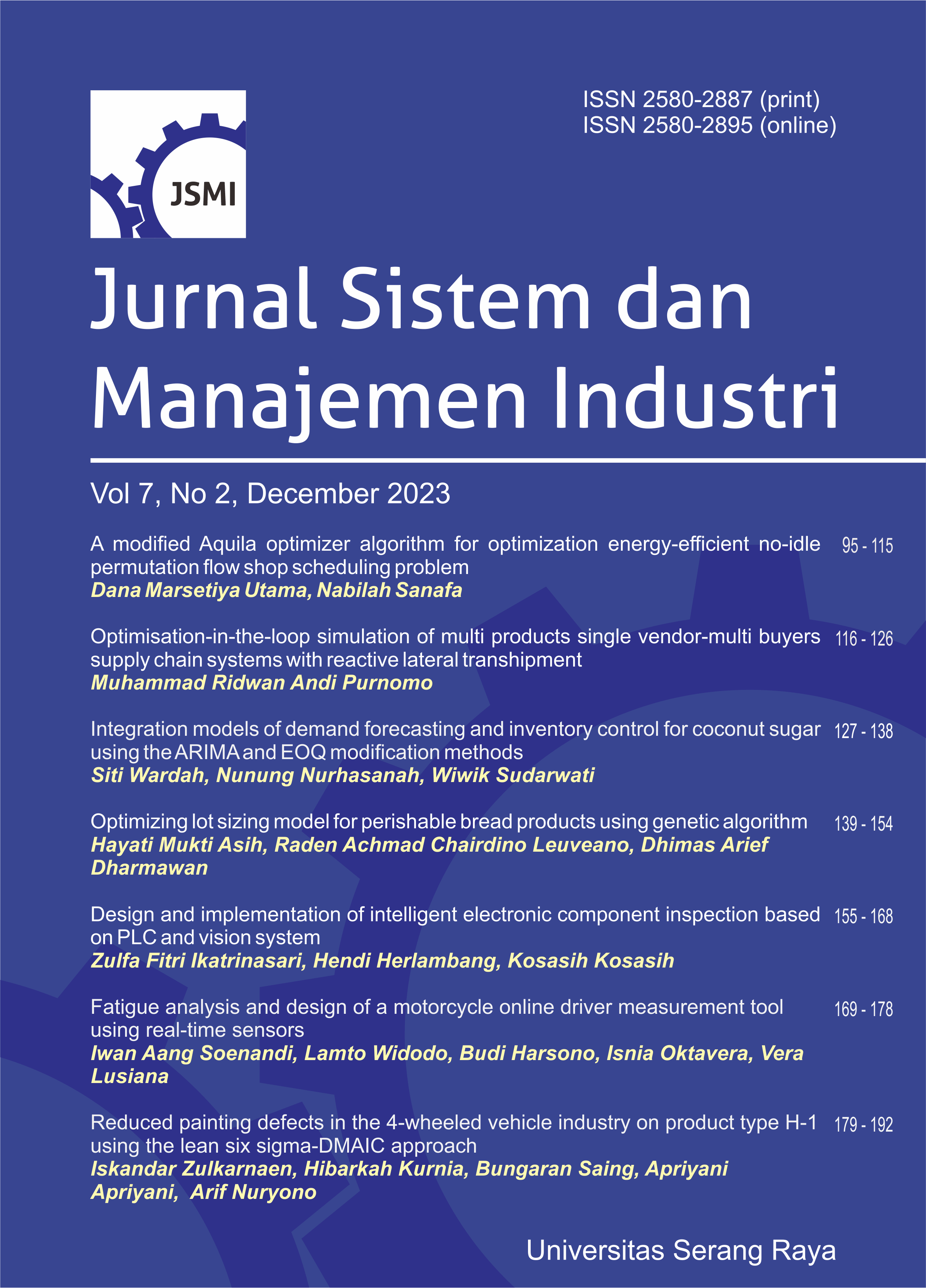Optimisation-in-the-loop simulation of multi products single vendor-multi buyers supply chain systems with reactive lateral transhipment
DOI:
https://doi.org/10.30656/jsmi.v7i2.6495Keywords:
Joint economic lot-size, Modified genetic algorithms (M-GA), Optimisation-in-the-loop simulation, Reactive lateral transhipment, Single vendor-multi buyersAbstract
Considering that batik is one of the most popular products in Indonesia, it is important to analyse the supply chain system for batik products. In reality, the supply chain system for batik products enables orders between buyers to receive products more rapidly, allowing them to anticipate stock outs and obtain lower ordering costs than when ordering from vendors. It is referred to as reactive lateral transshipment. This paper discusses the development of a simulation-based stochastic optimisation model for a batik product supply chain system with multiproducts and single vendor-multi buyers. The utilised solution searching algorithm is a modified Genetic Algorithms (GA) executed in-loop with the developed simulation-based stochastic model. The results demonstrate that the proposed modified GA is able to provide a global optimum solution, allowing the proposed simulation-based stochastic model to reduce the joint total cost (JTC) of the investigated supply chain system by up to 19% when compared to the local optimisation model in each supply chain party.
Downloads
References
M. Gutierrez and F. A. Rivera, ‘Undershoot and order quantity probability distributions in periodic review, reorder point, order-up-to-level inventory systems with continuous demand’, Appl. Math. Model., vol. 91, pp. 791–814, Mar. 2021, doi: https://doi.org/10.1016/j.apm.2020.09.014.
Y. Yu, B. Shou, Y. Ni, and L. Chen, ‘Optimal production, pricing, and substitution policies in continuous review production-inventory systems’, Eur. J. Oper. Res., vol. 260, no. 2, pp. 631–649, 2017, doi: https://doi.org/10.1016/j.ejor.2017.01.012.
S. H. R. Pasandideh, S. T. A. Niaki, and N. Tokhmehchi, ‘A parameter-tuned genetic algorithm to optimize two-echelon continuous review inventory systems’, Expert Syst. Appl., vol. 38, no. 9, pp. 11708–11714, 2011, doi: https://doi.org/10.1016/j.eswa.2011.03.056.
R. Patriarca, F. Costantino, and G. Di Gravio, ‘Inventory model for a multi-echelon system with unidirectional lateral transshipment’, Expert Syst. Appl., vol. 65, pp. 372–382, 2016, doi: https://doi.org/10.1016/j.eswa.2016.09.001.
B. Karimi, S. M. T. Fatemi Ghomi, and J. M. Wilson, ‘The capacitated lot sizing problem: a review of models and algorithms’, Omega, vol. 31, no. 5, pp. 365–378, 2003, doi: https://doi.org/10.1016/S0305-0483(03)00059-8.
R. Zheng, Y. Zhou, L. Gu, and Z. Zhang, ‘Joint optimization of lot sizing and condition-based maintenance for a production system using the proportional hazards model’, Comput. Ind. Eng., vol. 154, p. 107157, 2021, doi: https://doi.org/10.1016/j.cie.2021.107157.
M. Liu, H. Tang, F. Chu, F. Zheng, and C. Chu, ‘Joint optimization of lot-sizing and pricing with backlogging’, Comput. Ind. Eng., vol. 167, p. 107979, 2022, doi: https://doi.org/10.1016/j.cie.2022.107979.
M. E. Gurkan, H. Tunc, and S. A. Tarim, ‘The joint stochastic lot sizing and pricing problem’, Omega, vol. 108, p. 102577, 2022, doi: https://doi.org/10.1016/j.omega.2021.102577.
F. Otrodi, R. Ghasemy Yaghin, and S. A. Torabi, ‘Joint pricing and lot-sizing for a perishable item under two-level trade credit with multiple demand classes’, Comput. Ind. Eng., vol. 127, pp. 761–777, 2019, doi: https://doi.org/10.1016/j.cie.2018.11.015.
S. K. Goyal, ‘An integrated inventory model for a single supplier-single customer problem’, Int. J. Prod. Res., vol. 15, no. 1, pp. 107–111, Jan. 1977, doi: https://doi.org/10.1080/00207547708943107.
A. Banerjee, ‘A joint economicâ€lotâ€size model for purchaser and vendor’, Decis. Sci., vol. 17, no. 3, pp. 292–311, Jul. 1986, doi: https://doi.org/10.1111/j.1540-5915.1986.tb00228.x.
M. Ben-Daya and A. Al-Nassar, ‘An integrated inventory production system in a three-layer supply chain’, Prod. Plan. Control, vol. 19, no. 2, pp. 97–104, Mar. 2008, doi: https://doi.org/10.1080/09537280801895930.
H. M. Abdelsalam and M. M. Elassal, ‘Joint economic lot sizing problem for a three—Layer supply chain with stochastic demand’, Int. J. Prod. Econ., vol. 155, pp. 272–283, 2014, doi: https://doi.org/10.1016/j.ijpe.2014.01.015.
S. S. Sana, ‘Optimal production lot size and reorder point of a two-stage supply chain while random demand is sensitive with sales teams’ initiatives’, Int. J. Syst. Sci., vol. 47, no. 2, pp. 450–465, Jan. 2016, doi: https://doi.org/10.1080/00207721.2014.886748.
M. K. Sarakhsi, S. M. T. Fatemi Ghomi, and B. Karimi, ‘A new hybrid algorithm of scatter search and Nelder–Mead algorithms to optimize joint economic lot sizing problem’, J. Comput. Appl. Math., vol. 292, pp. 387–401, 2016, doi: https://doi.org/10.1016/j.cam.2015.07.027.
N. T. M. Hanh, J. M. Chen, and N. Van Hop, ‘Pricing strategy and order quantity allocation with price-sensitive demand in three-echelon supply chain’, Expert Syst. Appl., vol. 206, p. 117873, 2022, doi: https://doi.org/10.1016/j.eswa.2022.117873.
L. Liu, Q. Zhao, and M. Goh, ‘Perishable material sourcing and final product pricing decisions for two-echelon supply chain under price-sensitive demand’, Comput. Ind. Eng., vol. 156, p. 107260, 2021, doi: https://doi.org/10.1016/j.cie.2021.107260.
D. P. Sari, A. Rusdiansyah, and L. Huang, ‘Models of Joint Economic Lot-sizing Problem with Time-based Temporary Price Discounts’, Int. J. Prod. Econ., vol. 139, no. 1, pp. 145–154, 2012, doi: https://doi.org/10.1016/j.ijpe.2011.12.014.
B. Marchi, J. M. Ries, S. Zanoni, and C. H. Glock, ‘A joint economic lot size model with financial collaboration and uncertain investment opportunity’, Int. J. Prod. Econ., vol. 176, pp. 170–182, 2016, doi: https://doi.org/10.1016/j.ijpe.2016.02.021.
A. Tolooie, M. Maity, and A. K. Sinha, ‘A two-stage stochastic mixed-integer program for reliable supply chain network design under uncertain disruptions and demand’, Comput. Ind. Eng., vol. 148, p. 106722, 2020, doi: https://doi.org/10.1016/j.cie.2020.106722.
M. Meneses, D. Santos, and A. Barbosa-Póvoa, ‘Modelling the Blood Supply Chain’, Eur. J. Oper. Res., vol. 307, no. 2, pp. 499–518, 2023, doi: https://doi.org/10.1016/j.ejor.2022.06.005.
P. Emadi and Z. J. Pasek, ‘Blood Shortage Management with a Reactive Lateral Transshipment Approach in a Local Blood Supply Chain’, in Proceedings of the International Conference on Industrial Engineering and Operations Management, 2021, pp. 319–330, [Online]. Available: http://www.ieomsociety.org/brazil2020/papers/142.pdf.
M. Dehghani, B. Abbasi, and F. Oliveira, ‘Proactive transshipment in the blood supply chain: A stochastic programming approach’, Omega, vol. 98, p. 102112, 2021, doi: https://doi.org/10.1016/j.omega.2019.102112.
C. N. Samuel, C. Diallo, U. Venkatadri, and S. Ghayebloo, ‘Multicomponent multiproduct closed-loop supply chain design with transshipment and economies of scale considerations’, Comput. Ind. Eng., vol. 153, p. 107073, 2021, doi: https://doi.org/10.1016/j.cie.2020.107073.
A. S. Dijkstra, G. Van der Heide, and K. J. Roodbergen, ‘Transshipments of cross-channel returned products’, Int. J. Prod. Econ., vol. 209, pp. 70–77, 2019, doi: https://doi.org/10.1016/j.ijpe.2017.09.001.
F. E. Achamrah, F. Riane, and S. Limbourg, ‘Spare parts inventory routing problem with transshipment and substitutions under stochastic demands’, Appl. Math. Model., vol. 101, pp. 309–331, Jan. 2022, doi: https://doi.org/10.1016/j.apm.2021.08.029.
M. Firouz, B. B. Keskin, and S. H. Melouk, ‘An integrated supplier selection and inventory problem with multi-sourcing and lateral transshipments’, Omega, vol. 70, pp. 77–93, Jul. 2017, doi: https://doi.org/10.1016/j.omega.2016.09.003.
A. Dhahri, A. Gharbi, and M. Ouhimmou, ‘Integrated production-transshipment control policy for a two-location unreliable manufacturing system’, Int. J. Prod. Econ., vol. 247, p. 108440, 2022, doi: https://doi.org/10.1016/j.ijpe.2022.108440.
K.-M. Wang, K.-J. Wang, and C.-C. Chen, ‘Capacitated production planning by parallel genetic algorithm for a multi-echelon and multi-site TFT-LCD panel manufacturing supply chain’, Appl. Soft Comput., vol. 127, p. 109371, 2022, doi: https://doi.org/10.1016/j.asoc.2022.109371.
H. Gholizadeh and H. Fazlollahtabar, ‘Robust optimization and modified genetic algorithm for a closed loop green supply chain under uncertainty: Case study in melting industry’, Comput. Ind. Eng., vol. 147, p. 106653, 2020, doi: https://doi.org/10.1016/j.cie.2020.106653.
M. Fathi, M. Khakifirooz, A. Diabat, and H. Chen, ‘An integrated queuing-stochastic optimization hybrid Genetic Algorithm for a location-inventory supply chain network’, Int. J. Prod. Econ., vol. 237, p. 108139, 2021, doi: https://doi.org/10.1016/j.ijpe.2021.108139.
N. Nezamoddini, A. Gholami, and F. Aqlan, ‘A risk-based optimization framework for integrated supply chains using genetic algorithm and artificial neural networks’, Int. J. Prod. Econ., vol. 225, p. 107569, 2020, doi: https://doi.org/10.1016/j.ijpe.2019.107569.
A. Seidscher and S. Minner, ‘A Semi-Markov decision problem for proactive and reactive transshipments between multiple warehouses’, Eur. J. Oper. Res., vol. 230, no. 1, pp. 42–52, 2013, doi: https://doi.org/10.1016/j.ejor.2013.03.041.
Z. Michalewicz, Genetic Algorithms + Data Structures = Evolution Programs. Berlin, Heidelberg: Springer Berlin Heidelberg, 1996, https://doi.org/ 10.1007/978-3-662-03315-9.
D. Waters and S. Rinsler, Global Logistics: New Directions in Supply Chain Management. Kogan Page, 2014, [Online]. Available: http://www.ieomsociety.org/brazil2020/papers/142.pdf.
Downloads
Published
Issue
Section
License
All articles in Jurnal Sistem dan Manajemen Industri can be disseminated provided they include the identity of the article and the source of the article Jurnal Sistem dan Manajemen Industri. The publisher is not responsible for the contents of the article. The content of the article is the sole responsibility of the author
Jurnal Sistem dan Manajemen Industri is licensed under a Creative Commons Attribution-NonCommercial-ShareAlike 4.0 International License.
















1.png)
.png)
.png)
.png)


